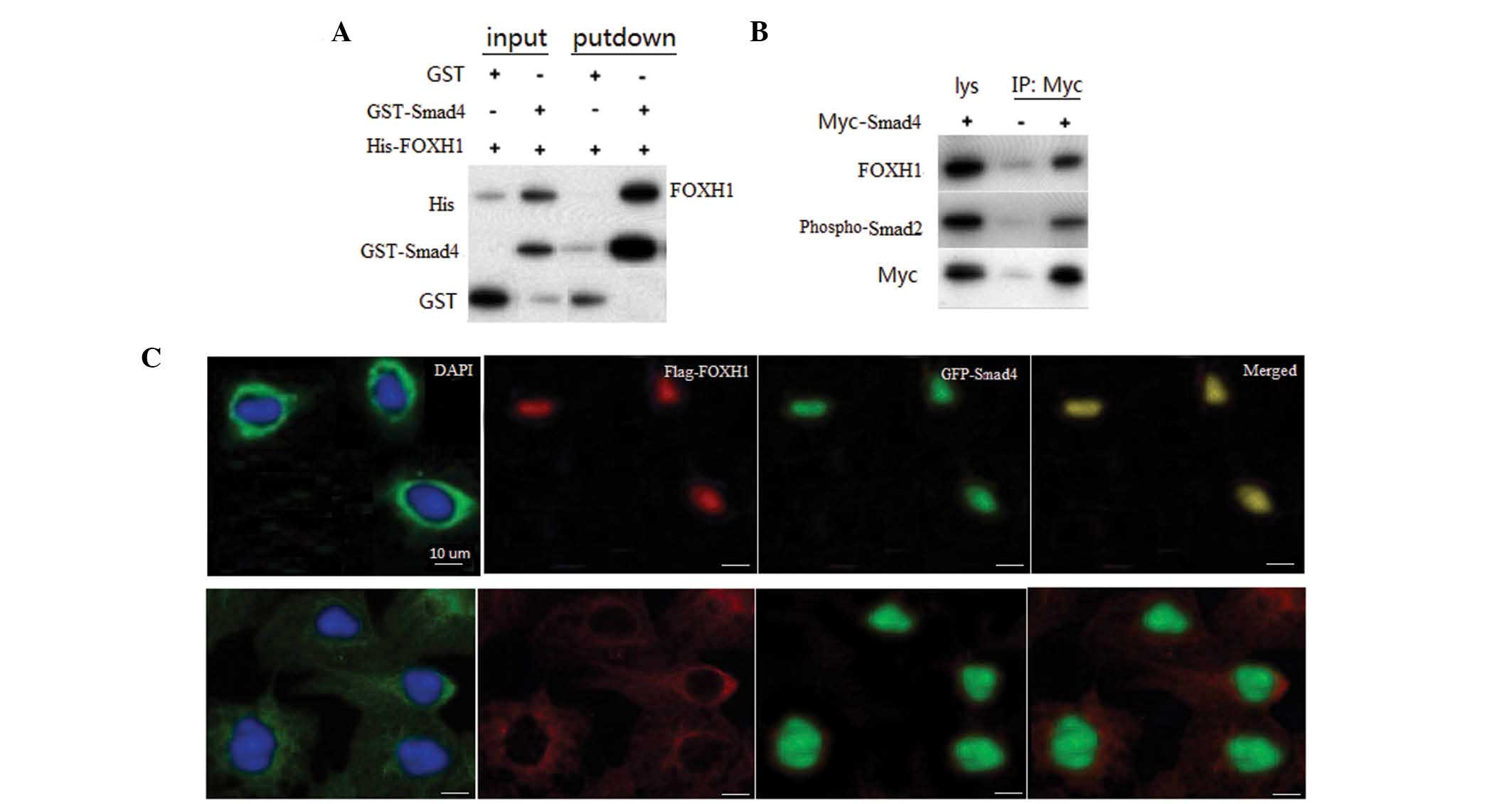|
1
|
Sheehan JP, Sun MH, Kondziolka D,
Flickinger J and Lunsford LD: Radiosurgery in patients with renal
cell carcinoma metastasis to the brain: long-term outcomes and
prognostic factors influencing survival and local tumor control. J
Neurosurg. 98:342–349. 2003. View Article : Google Scholar : PubMed/NCBI
|
|
2
|
Ljungberg B, Hanbury DC, Kuczyk MA, et al;
European Association of Urology Guideline Group for renal cell
carcinoma. Renal cell carcinoma guideline. Eur Urol. 51:1502–1510.
2007. View Article : Google Scholar : PubMed/NCBI
|
|
3
|
Linehan WM: The genetic basis of kidney
cancer: implications for management and use of targeted therapeutic
approaches. Eur Urol. 61:896–898. 2012. View Article : Google Scholar : PubMed/NCBI
|
|
4
|
Jacobs JF, Nierkens S, Figdor CG, de Vries
IJM and Adema GJ: Regulatory T cells in melanoma: the final hurdle
towards effective immunotherapy? Lancet Oncol. 13:e32–e42. 2012.
View Article : Google Scholar : PubMed/NCBI
|
|
5
|
de Jesus-Gonzalez N, Robinson E, Moslehi J
and Humphreys BD: Management of antiangiogenic therapy-induced
hypertension. Hypertension. 60:607–615. 2012. View Article : Google Scholar : PubMed/NCBI
|
|
6
|
Zhu Y, Xu L, Zhang J, et al: Klotho
suppresses tumor progression via inhibiting PI3K/Akt/GSK3β/Snail
signaling in renal cell carcinoma. Cancer Sci. 104:663–671. 2013.
View Article : Google Scholar : PubMed/NCBI
|
|
7
|
Kim BG, Li C, Qiao W, et al: Smad4
signalling in T cells is required for suppression of
gastrointestinal cancer. Nature. 441:1015–1019. 2006. View Article : Google Scholar : PubMed/NCBI
|
|
8
|
Wang LH, Kim SH, Lee JH, et al:
Inactivation of SMAD4 tumor suppressor gene during gastric
carcinoma progression. Clin Cancer Res. 13:102–110. 2007.
View Article : Google Scholar : PubMed/NCBI
|
|
9
|
Müller N, Reinacher-Schick A, Baldus S, et
al: Smad4 induces the tumor suppressor E-cadherin and P-cadherin in
colon carcinoma cells. Oncogene. 21:6049–6058. 2002. View Article : Google Scholar : PubMed/NCBI
|
|
10
|
Losi L, Bouzourene H and Benhattar J: Loss
of Smad4 expression predicts liver metastasis in human colorectal
cancer. Oncol Rep. 17:1095–1099. 2007.PubMed/NCBI
|
|
11
|
Alazzouzi H, Alhopuro P, Salovaara R, et
al: SMAD4 as a prognostic marker in colorectal cancer. Clin Cancer
Res. 11:2606–2611. 2005. View Article : Google Scholar : PubMed/NCBI
|
|
12
|
Goto Y, Manabe N, Uchio-Yamada K, et al:
Augmented cytoplasmic Smad4 induces acceleration of TGF-beta1
signaling in renal tubulointerstitial cells of hereditary nephrotic
ICGN mice with chronic renal fibrosis; possible role for
myofibroblastic differentiation. Cell Tissue Res. 315:209–221.
2004. View Article : Google Scholar
|
|
13
|
Derynck R and Zhang YE: Smad-dependent and
Smad-independent pathways in TGF-beta family signalling. Nature.
425:577–584. 2003. View Article : Google Scholar : PubMed/NCBI
|
|
14
|
ten Dijke P and Hill CS: New insights into
TGF-β-Smad signalling. Trends Biochem Sci. 29:265–273. 2004.
View Article : Google Scholar : PubMed/NCBI
|
|
15
|
Hoodless PA, Tsukazaki T, Nishimatsu S,
Attisano L, Wrana JL and Thomsen GH: Dominant-negative Smad2
mutants inhibit activin/Vg1 signaling and disrupt axis formation in
Xenopus. Dev Biol. 207:364–379. 1999. View Article : Google Scholar : PubMed/NCBI
|
|
16
|
Attisano L and Wrana JL: Smads as
transcriptional co-modulators. Curr Opin Cell Biol. 12:235–243.
2000. View Article : Google Scholar : PubMed/NCBI
|
|
17
|
Yum J, Jeong HM, Kim S, et al:
PKA-mediated stabilization of FoxH1 negatively regulates ERalpha
activity. Mol Cells. 28:67–71. 2009. View Article : Google Scholar : PubMed/NCBI
|
|
18
|
Bhat HK, Hacker HJ, Bannasch P, Thompson
EA and Liehr JG: Localization of estrogen receptors in interstitial
cells of hamster kidney and in estradiol-induced renal tumors as
evidence of the mesenchymal origin of this neoplasm. Cancer Res.
53:5447–5451. 1993.PubMed/NCBI
|
|
19
|
Tsui K-H, Shvarts O, Smith Rb, Figlin Ra,
de Kernion J and Belldegrun A: Prognostic indicators for renal cell
carcinoma: a multivariate analysis of 643 patients using the
revised 1997 TNM staging criteria. J Urol. 163:1090–1095. 2000.
View Article : Google Scholar : PubMed/NCBI
|
|
20
|
Wu J-W, Hu M, Chai J, et al: Crystal
structure of a phosphorylated Smad2: Recognition of phosphoserine
by the MH2 domain and insights on Smad function in TGF-beta
signaling. Mol Cell. 8:1277–1289. 2001. View Article : Google Scholar
|
|
21
|
Shi Y, Hata A, Lo RS, Massagué J and
Pavletich NP: A structural basis for mutational inactivation of the
tumour suppressor Smad4. Nature. 388:87–93. 1997. View Article : Google Scholar : PubMed/NCBI
|
|
22
|
Itoh F, Asao H, Sugamura K, Heldin C-H,
ten Dijke P and Itoh S: Promoting bone morphogenetic protein
signaling through negative regulation of inhibitory Smads. EMBO J.
20:4132–4142. 2001. View Article : Google Scholar : PubMed/NCBI
|
|
23
|
Ju W, Ogawa A, Heyer J, et al: Deletion of
Smad2 in mouse liver reveals novel functions in hepatocyte growth
and differentiation. Mol Cell Biol. 26:654–667. 2006. View Article : Google Scholar :
|
|
24
|
Yao Z, Fenoglio S, Gao DC, et al: TGF-beta
IL-6 axis mediates selective and adaptive mechanisms of resistance
to molecular targeted therapy in lung cancer. Proc Natl Acad Sci
USA. 107:15535–15540. 2010. View Article : Google Scholar : PubMed/NCBI
|
|
25
|
Yamamoto M, Meno C, Sakai Y, et al: The
transcription factor FoxH1 (FAST) mediates Nodal signaling during
anterior-posterior patterning and node formation in the mouse.
Genes Dev. 15:1242–1256. 2001. View Article : Google Scholar : PubMed/NCBI
|
|
26
|
Chen G, Nomura M, Morinaga H, et al:
Modulation of androgen receptor transactivation by FoxH1 a newly
identified androgen receptor corepressor. J Biol Chem.
280:36355–36363. 2005. View Article : Google Scholar : PubMed/NCBI
|
|
27
|
Escudier B, Eisen T, Stadler WM, et al:
Sorafenib in advanced clear-cell renal-cell carcinoma. N Engl J
Med. 356:125–134. 2007. View Article : Google Scholar : PubMed/NCBI
|













